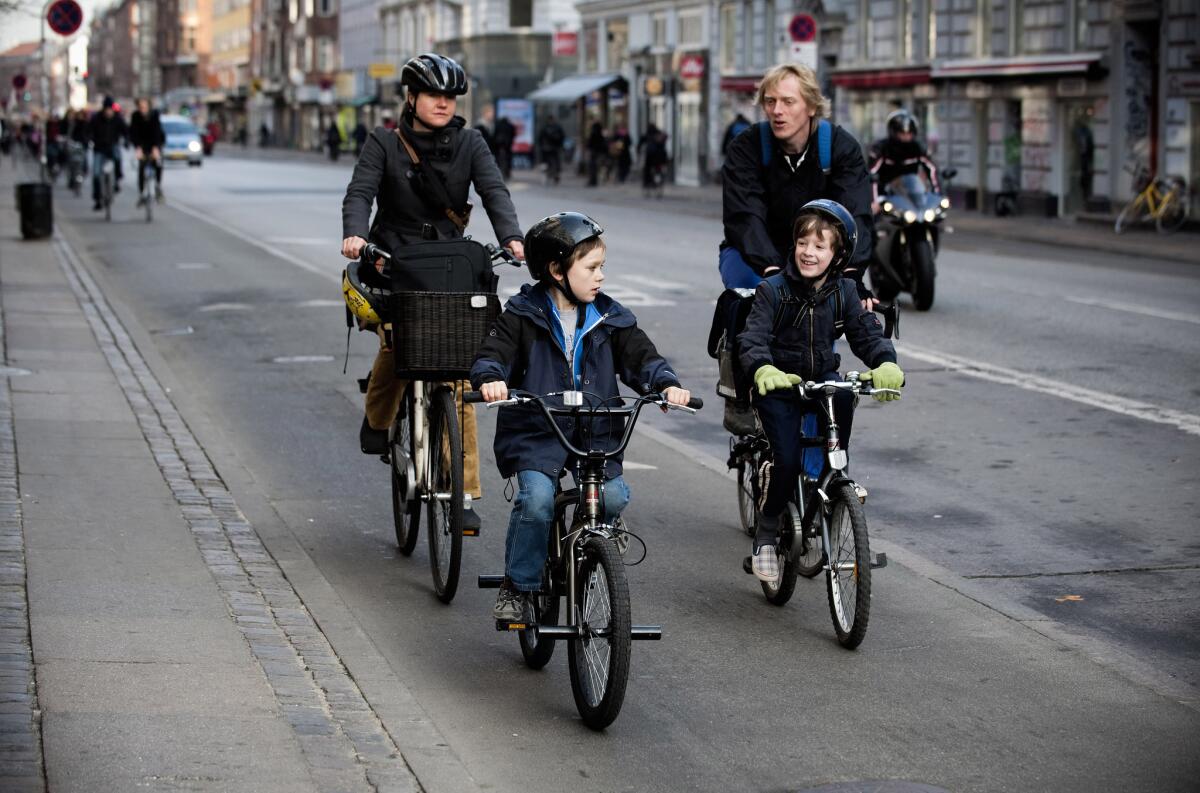Op-Ed: Let’s give poor women a real choice on family planning

A Danish family rides along a bicycle path in central Copenhagen in 2009.
- Share via
You’ve probably read this sentence, or one like it, many times: If we want to fight poverty, we need to nudge poor women away from having children. It’s an old social Darwinist line that’s been rebooted lately by centrist thought-leaders such as Isabel Sawhill of the Brookings Institution. But I have a better idea. If we want to fight poverty, we should provide a robust set of universal family welfare benefits so that even women with bad jobs can comfortably afford to have children.
Rallying behind the rhetoric of choice, the new opponents of poor people’s fertility no longer push for outright sterilization. Instead, they plead for the public to provide poor women with contraception — ideally long-acting reversible contraception that would require them to jump through hoops to undo. This, it is hoped, would cut down on poor women having poor babies, thereby reducing poverty and dreaded welfare spending along with it.
Here’s Catherine Rampell in the Washington Post: “I have a humble suggestion for an anti-poverty policy that, if framed correctly, could appeal to both left and right (though probably not [Pope] Francis). That policy: better access to contraception.”
Although sold as a way to give women control over when, whether and with whom to have children, free birth control by itself does nothing of the sort. Just as being unable to afford birth control means you don’t have a genuine choice on contraception, being unable to afford a child means you don’t have a genuine choice to start a family.
To truly make all family choices available, we need to ensure that both contraception and raising a child are affordable for everyone. For the affluent, there are no economic impediments to either having or not having a child. Giving poor women free contraception is said to extend to them the reproductive choices available to rich women, but this is obviously not true. After receiving free contraception, a poor woman has only one comfortable option available: to use contraception to avoid having a child. The rich woman’s option of comfortably having children remains out of reach.
Instead of pursuing poverty reduction and welfare cuts through a grotesque program of dulling the fertility of women at the bottom of society, we should massively increase family welfare benefits. Such a proposal is out of the bounds of respectable policy thought in the United States, but it’s commonplace elsewhere.
Consider Denmark. In recent years, Denmark’s child poverty rate has hovered between 2% and 4%, which is tied with Finland for the lowest in the world. There are a number of reasons for this, but Denmark’s welfare system plays the biggest part. In 2011, Denmark spent about 4% of its gross domestic product on family benefits. In terms of U.S. GDP, that’s the equivalent of $620 billion.
The United States, to its great detriment, is stingy where Denmark is generous. In 2011, the U.S. spent just 0.7% of its GDP on family benefits, which puts it at the bottom of the developed world. Not coincidentally, the U.S. child poverty rate hovers around 20%, which is higher than almost all other peer nations.
My radical idea — which isn’t really radical at all — is that to become more like Denmark in terms of low child poverty, we should become more like Denmark in terms of family benefits. This idea won’t fill the seats of Washington think tank panel talks, and there is no grant money to be had pushing it, but despite those faults, it has a proven track record.
What would expanded family welfare benefits look like? Imagine, if you can, generous paid leave to take care of newborns, universal child-care benefits, free education from kindergarten through college, free lunches at school, free healthcare and even a monthly check directly deposited to your bank account for every child you have. Does it seem like I’m describing a dreamy fantasy land? That’s actually just a partial rundown of what Finland, another family-friendly nation, offers its citizens.
American pundits and policy experts are enamored of cost-less ways to reduce poverty. When it’s not the newfangled politics of contraception, it’s educational reforms, or even the perennial favorite of hectoring about marriage. These approaches typically fail for the obvious reason that what poor people lack is money and none of these things actually provide them any.
For childbearing to truly be one option among many (including contraception), it must be as genuinely attainable as any other choice — a circumstance available to vast swathes of poor people only through the creation of additional welfare programs. A contraception-only plan, without the addition of new and robust programs for parents and kids, is the eugenics of yesteryear redressed in modern terms.
Matthew Bruenig is a researcher of poverty, inequality and welfare systems.
Follow the Opinion section on Twitter @latimesopinion and Facebook
More to Read
A cure for the common opinion
Get thought-provoking perspectives with our weekly newsletter.
You may occasionally receive promotional content from the Los Angeles Times.










